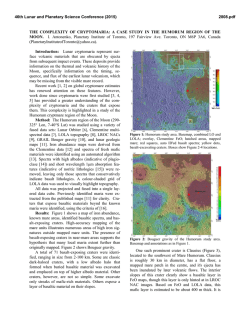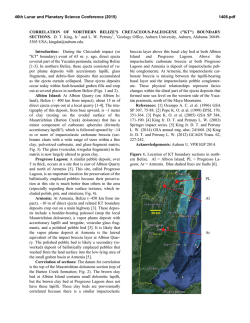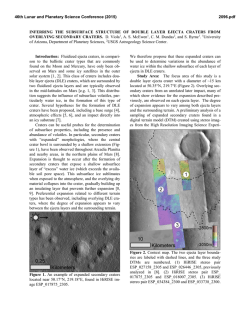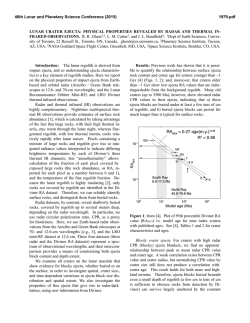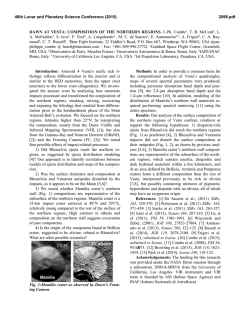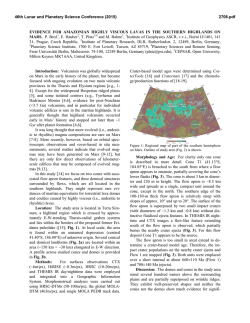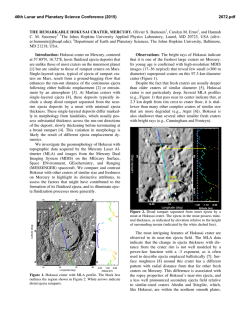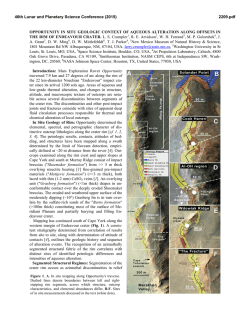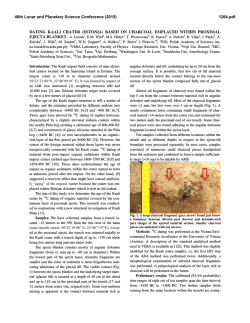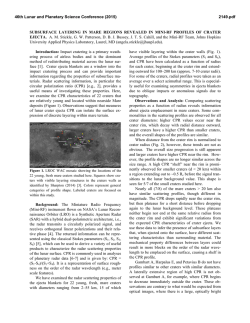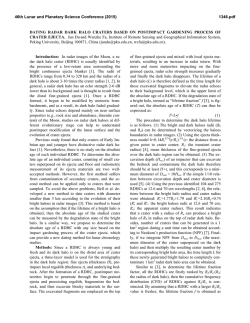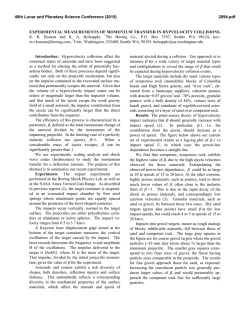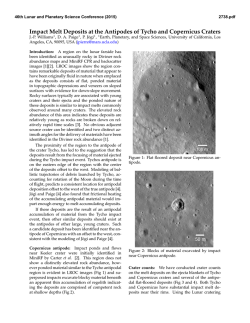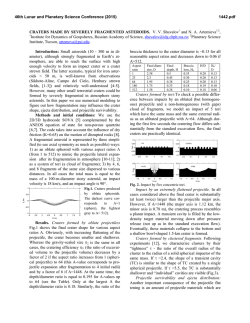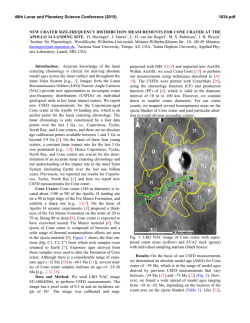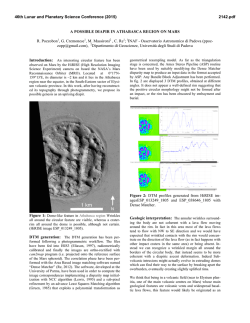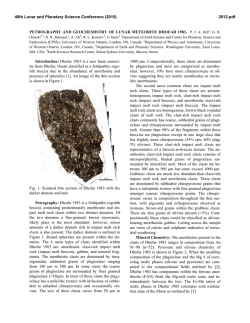
THE TSENKHER STRUCTURE, GOBI
46th Lunar and Planetary Science Conference (2015) 1338.pdf THE TSENKHER STRUCTURE, GOBI-ALTAI, MONGOLIA: A PROBABLE IMPACT CRATER WITH WELL-PRESERVED RAMPART EJECTA. G. Komatsu 1, J. Ormö2, T. Bayaraa3, T. Arai4, K. Nagao5, L. Gereltsetseg6, S. Tserendug3, K. Goto7, Y. Hidaka8, N. Shirai9, M. Ebihara9, S. Demberel3, and T. Matsui4, 1International Research School of Planetary Sciences, Università d'Annunzio, Italy ([email protected]), 2Centro de Astrobiologia, INTA-CSIC, Spain, 3Research Center of Astronomy and Geophysics, Mongolian Academy of Sciences, Mongolia, 4Planetary Exploration Research Center, Chiba Institute of Technology, Japan, 5Geochemical Research Center, University of Tokyo, Japan, 6Paleontological Center, Mongolian Academy of Sciences, Mongolia, 7International Research Institute of Disaster Science, Tohoku Univ., Japan, 8Laboratoire G-Time, Universite Libre de Bruxelles, Brussels, Belgium, 9Department of Chemistry, Tokyo Metropolitan University, Japan. Introduction: Tsenkher (Mong. Цэнхэр), located deep in the Gobi-Altai region of Mongolia (N 43°38’41’’, E 98°22’09’’), is a near-circular crater structure occurring in a structural basin (valley) (Fig. 1). The diameter of the apparent raised rim is on an average 3.6–3.7 km with a variable range of 3.5 km up to about 4 km, and a breccia layer extending to approximately one crater radius outside of the crater rim, suggests the presence of an ejecta blanket. The Tsenkher structure has been proposed to be either an impact crater or a maar/tuff ring based primarily on geomorphological observations mainly from remote sensing data and a brief visit in 1998 [1]. A combined geophysical survey (gravity and magnetic) conducted in 2007 gave support to a formation by an impact [2]. The impact hypothesis is a viable alternative to the volcanic one because of 1) a lack of clear association of the Tsenkher structure with other volcanic features, 2) general absence of volcanic rocks in the exposed bedrock and uplifted rim materials except for mm-scale rounded volcanic clasts apparently transported in from surrounding massifs composed of older strata, 3) a geophysical survey indicating a rootless structure with no major magma chamber under the structure [2], and 4) geological and geomorphological similarities to known impact craters of similar size. An 40Ar-39Ar dating of a melt clast sample gave 4.9 ± 0.9 Ma [3]. This is inconsistent with other volcanic activities in region, which have reported ages of 30–88 Ma [4][5]. Fig. 1. Satellite view of the Tsenkher structure. Origin: volcanic vs. impact: If following the volcanic hypothesis, we consider that the Tsenkher structure most likely is a maar/tuff ring as hypothesized by [1], considering its raised rim and the presence of ejecta and the absence of volcanic rocks except for the rare occurrences of melt clast breccias. However, the Tsenkher structure lacks characteristics that are indicative for known maars/tuff rings. Maars/tuff rings often show structural control (e.g., positioned along faults) [6], which is not observed at Tsenkher. The bedded base surge deposits commonly associated with maars/tuff rings (e.g., [7]) are not observed at Tsenkher either, although we can not totally rule out the possibility of their removal by erosion. Maars/tuff rings do not notably exhibit structurally uplifted pre-existing strata [8][9], and very large clasts in their ejecta are rare. This is inconsistent with Tsenkher where the pre-existing sedimentary bedrock layers are uplifted and large clasts up to m-scale are commonly observed in the ejecta layer. All the above-mentioned arguments make the Tsenkher structure a very unusual volcanic landform if of volcanic origin. The 3.7 km diameter of Tsenkher places the structure in the range of simple crater – complex crater transition diameter (2–4 km; [10]) in sedimentary target rocks. And this may explain at least partially the measured variable rim-to-rim diameter if some inner parts of the rim topography represent rim materials downshifted by normal faults during the modification stage [11]. Fig. 2. Characteristic lithology of Tsenkher. (A) Dark and greenish breccia occurring on top of the rim. (B) The dark clasts (melt) in polymict breccias exhibit contact alteration of the matrix. (C) A melt clast within a polymict breccia occurring in the ejecta layer just outside the rim. (D) Spherules millimeters in diameter are found in clast-rich melt rock samples from the north rim. 46th Lunar and Planetary Science Conference (2015) It is to be noted that no clear mineralogical [3] and geochemical evidence for the impact origin has been found to date. However, the general lithological and petrographic characteristics (e.g., Fig. 2) of Tsenkher are in good agreement with known impact structures [3], including injection features [12], mixed, non-stratified ejecta facies [13], suevite [14], vesicular melt clasts [15], and spherules [16]. The results of geochemical studies do not provide unequivocal evidence for an impact origin of the Tsenkher structure. However, the platinum group elemental abundance in the melt clast sample shows an elevated trend with respect to the sedimentary bedrock of the area (approximately an order of magnitude), and noble gas analysis of one breccia sample yielded a very high 3He/4He value of (5.0 ± 0.2) × 10-6. The impact origin will remain a hypothesis until it will be proven with the well-accepted impact criteria. Nonetheless, a volcanic origin for the Tsenkher structure requires very unconventional processes to produce a structure that satisfies the many morphological and lithological characteristics common to impact craters, but rarely observed with or absent from known volcanic structures. Rampart ejecta: The prominent ridge feature positioned about 1–2 km outside of the crater rim (about one crater radius) on the eastern side (Fig. 1) was noted in an earlier remote-sensing study by [1] who called it an “outer ridge”. We here choose to refer to this feature as a “rampart” since it strongly resembles rampart ridges associated with a certain morphological variety of ejecta blanket associated with many Martian impact craters (e.g., [17][18]). Close-up examination of the outcrops of the Tsenkher rampart reveals a mixed, non-stratified facies of large angular fragments (gravels to up to meter-scale boulders) and a poorly consolidated fine-grained (sandy) matrix (Fig. 3). Blocks of wellconsolidated breccia with similar appearance as the polymict, primarily chert-rich breccia of the proximal ejecta at the rim, as well as blocks of suevite-like rock, do also occur in the mixed deposit, thus giving a “breccia in breccia” appearance notwithstanding the mostly unconsolidated appearance of the host material of the rampart ejecta deposit. Both matrix- and clast-supported varieties exist but no clear stratification is observed. The large clasts in some cases appear to concentrate in the upper portions of the rampart (Fig. 3). The mixed, non-stratified facies is best interpreted as that of a debrisflow deposit. The existence of melt fragments in the blocks indicates that rapid consolidation must have occurred before further emplacement by the debris flow. The concentration of large clasts in the upper portions may be explained by the kinetic sieving process [19]. The debris-flow facies of the outer ridge indicates that the ridge materials were emplaced after its ground-hugging motion. Ground-hugging movement of ballistic ejecta and of crater rim materials that were structurally uplifted is envisaged. The inclusion of suevite-like breccia blocks in the chaotic deposit of the rampart possibly provides information on the timing of both the lithification of the suevite-like rock and its emplacement with respect to the 1338.pdf ejection process responsible for the rampart ejecta layer. In case the Tsenkher structure can be proven to be of impact origin, the well-preserved ejecta layer and cross-section through the rampart will offer a unique opportunity to study fluidized ejecta emplacement at impacts. Fig. 3. Rampart ejecta of the Tsenkher structure. A) View from the rim. B) Cross section of the rampart. References: [1] Komatsu G. et al. (2006) Geomorphology, 74, 164–180. [2] Ormö J. et al. (2010) MAPS, 45, 373– 382. [3] Komatsu G. et al. (2015), in preparation. [4] Yarmolyuk V. V. et al. (2007) J. Volcanology and Seismology, 1, 1– 27. [5] Barry T. L. et al. (2003) J. Petrology, 44, 55–91. [6] Gevrek A. I. and Kazanci N. (2000) JVGR, 95, 309–317. [7] Fisher R. V. and Waters A. C. (1070) Am. J. Sci., 268, 157– 180. [8] De Hon R. A. (1965) In: Guidebook to 15th Field Conference, New Mexico Geol. Soc., p. 204–209. [9] Gutmann J. T. (1976) Geol. Soc. America Bull., 87, 1718–1729. [10] Grieve R. A. F. (1987) Ann. Rev. Earth Planet. Sci., 15, 245–270. [11] Melosh H. J. (1989) Impact cratering: A geologic process, Oxford University Press, 245 p. [12] Sturkell E. R. R. and Ormö J. (1997) Sedimentology, 44, 793–804. [13] Kenkmann T. and Schönian F. (2006) MAPS, 41, 1587– 1604. [14] Stöffler D. and Grieve R. A. F. (1994) LPS XXV, 1347–1348. [15] Osae S. et al. (2005) MAPS, 40, 1473–1492. [16] Maloof A. et al. (2010) Geol. Soc. America Bull., 122, 109–126. [17] Barlow et al. (2000) JGR, 105, 26,733– 26,738. [18] Komatsu G. et al. (2007) JGR, 112(E6), doi: 10.1029/2006JE002787. [19] Pouliquen O. and Vallance J. W. (1999) Chaos, 9, 621–629.
© Copyright 2025
